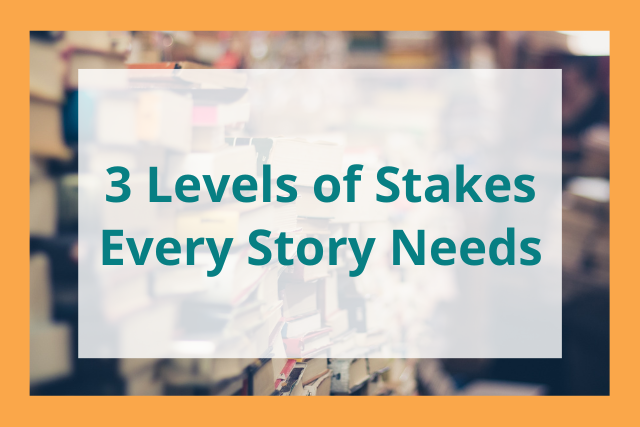
The protagonist of every great story has something to lose.
That’s what makes the reader care about the protagonist’s goals—because of what’s at stake if they fail.
In the best novels and movies, there’s rarely just one thing the protagonist has at stake. Instead, there are three types of stakes in play, each of which engages the reader in a different way.
So, what are these three types, and how can you incorporate them into your own stories?
This article will explain the three levels of stakes, discuss some examples from literature, and give you our best tips for crafting strong stakes in your own writing.
What Are Stakes in Fiction?
When we use the word “stakes” while discussing a story, we’re talking about what a character has to lose.
You can figure out the stakes of a story by asking this question: What’s at risk for this character if they don’t succeed in achieving their goals?
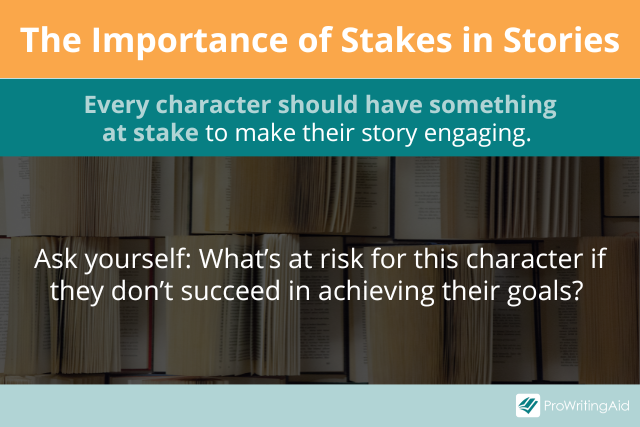
In a romance, it might be a future with the person they love. In a horror story, it might be the survival of their family. In fantasy or sci-fi, it might even be the fate of their entire world.
Strong stakes make the reader feel invested and engaged. If there’s nothing at stake in a story, the reader has no reason to care about what happens to the protagonist.
For example, imagine reading a story about a man whose car has broken down in the middle of the road.
How much do you care about finding out what happens next? The answer depends on what’s at stake for this character.
If the man is simply driving home at the end of a normal day, you might feel sympathetic to his plight, but you won’t necessarily be on the edge of your seat to find out what happens next.
On the other hand, if he’s driving to the hospital for the imminent birth of his first child, you suddenly care a lot more about whether his car gets fixed.
That’s because, in the first scenario, the only thing the protagonist had to lose was a few normal hours at home. In the second scenario, he could potentially miss out on the moment he becomes a father.
What the protagonist has to lose—in other words, the stakes of the story—makes the second story feel much more interesting and significant than the first.
What Are the Three Levels of Stakes?
The greatest stories give the protagonist something to lose on three different levels. This gives the story depth and ensures the reader feels invested in more ways than one.
The three levels of stakes are:
- Public stakes
- Personal stakes
- Philosophical stakes
Let’s look at each level in more detail.
Level 1: Public Stakes
Public stakes, also called external stakes, are the most obvious level of stakes.
Public stakes are the externally visible things the protagonist has to lose that affect the most people. It’s the direct consequence of the protagonist failing to achieve their story goals.
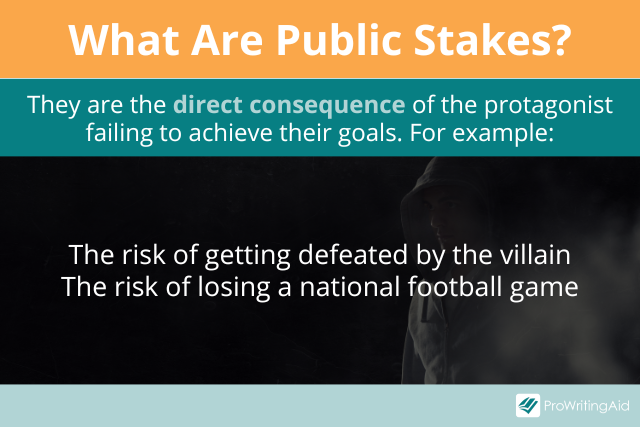
In a sports story, it’s the risk of losing the big game, which would affect the whole team and all their fans.
In a war story, it’s the risk of losing the war, which would affect the whole military and everyone they’re defending.
In a monster story, it’s the risk of failing to defeat the monster, which would affect everyone the monster might then go on to harm.
For example, imagine a superhero who’s trying to stop a supervillain from detonating a bomb that will destroy an entire city. The public stakes are clear here, since the lives of many people are on the line, and the entire city cares about whether the hero wins or loses.
Level 2: Personal Stakes
Not all stakes have to matter to everyone. Sometimes the protagonist has something to lose that matters only to themselves, or sometimes to themselves and a single other person.
These are called personal stakes.
Personal stakes are also known as internal stakes, emotional stakes, or relationship stakes. This level of stakes usually involves the protagonist’s internal feelings about a single person, such as a family member, a love interest, or a close friend.
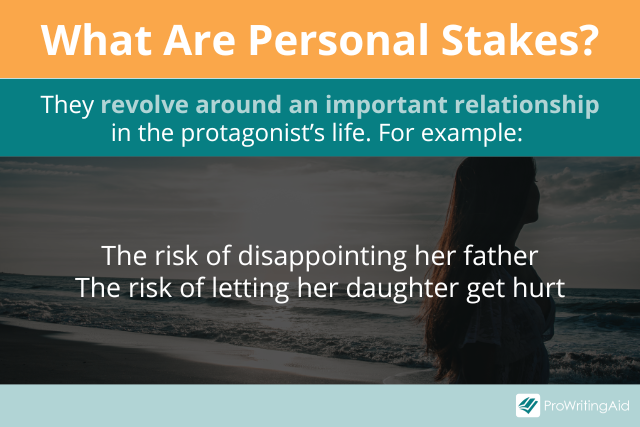
In a sports story, for example, the personal stakes might be the protagonist’s fear of disappointing her father, who sacrificed his own dreams to support her career as an athlete. Her father’s disappointment wouldn’t affect anyone else, but it probably matters a lot to her—maybe even more than the game itself.
In a war story, the personal stakes might be a romantic relationship, such as a girlfriend or boyfriend the protagonist wants to protect.
Often, personal stakes can grab readers’ attention and sympathy even better than public stakes.
As an example, let’s return to the story of the superhero who’s trying to stop the supervillain from destroying a city. So far, the reader might not be very invested in whether the superhero wins, since losing only affects a faceless crowd of people.
On the other hand, if the superhero has a young daughter who will die if he doesn’t defeat the supervillain, we suddenly care a lot more about the outcome of the story because it affects the hero on a personal level.
Level 3: Philosophical Stakes
Philosophical stakes are the highest level of stakes.
Philosophical stakes are what the protagonist has to lose on an abstract level—a value or belief they hold dear, which will be proven wrong if they fail to achieve their goals.
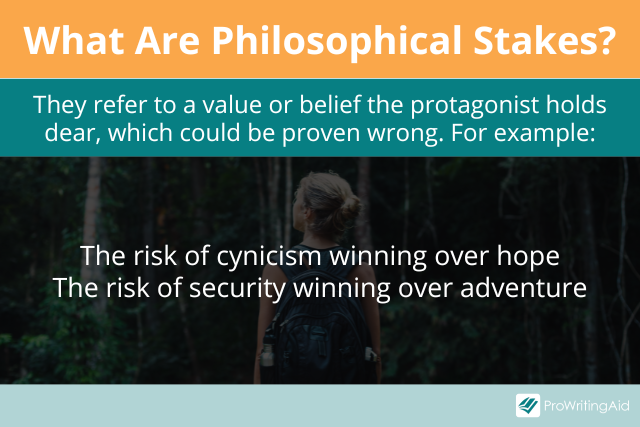
You can create philosophical stakes by establishing two different value systems in the story and letting them compete for dominance. One value system is embodied by the protagonist, and the other is embodied by the antagonist.
In a family drama where a daring teenager rebels against her overprotective parents, the competing values might be adventure vs security. If the teenager ends up accepting her parents’ point of view, she could lose her belief that life should be an adventure.
In a war story between two countries with different political systems, the competing values might be democracy vs fascism. If the fascist country defeats the democratic country at the end of the story, they’re also defeating the belief that people should be free and self-governing.
Let’s return to our superhero example one last time. Perhaps the superhero believes that human life is sacred and deserves to be protected, while the villain believes that humans are fundamentally corrupt and deserve to be punished.
Now the superhero has something to lose on three different levels: the survival of the city, the young daughter he loves, and his belief that human life is sacred.
Why Is It Important to Include All Three Levels of Stakes?
Crafting three levels of stakes for every story might sound like a lot of work, but it’s worth the effort.
That’s because each type of stake engages the reader in a different way:
- The public stakes drive plot. They make the protagonist’s story goals feel significant and noteworthy.
- The personal stakes drive character. They make us care about the protagonist and their relationships on an emotional level.
- The philosophical stakes drive theme. They add deeper thematic meaning to the story.
When one level is missing, the story can feel overly simplistic. Picture a shallow action movie with no philosophical stakes—there might be plenty of explosions and car chases, but the thematic layer will feel like it's missing.
[Image 5]
When these three levels work together, they create a deeply impactful story that will keep readers turning the pages.
Examples of the Three Levels of Stakes in Literature
Let’s look at the three levels of stakes in some famous works of English literature.
Example 1: Frankenstein by Mary Shelley
Frankenstein tells the story of Victor Frankenstein, a scientist who constructs a sentient monster, condemning it to a lifetime of loneliness.
You might see the monster as the protagonist and Victor as the antagonist, or Victor as the protagonist and the monster as the antagonist. Each of these two characters has a different set of stakes since Victor and the monster are afraid of losing different things.
For our purposes, let’s view the monster as the protagonist. These are the stakes for Frankenstein’s monster:
Public stakes: The monster could lose his life since many people see him as an aberration and want him dead.
Personal stakes: The monster wants to have a family or a female companion, so he doesn’t have to live his life friendless and alone.
Philosophical stakes: The monster risks proving society right about the idea that he’s a dangerous abomination.
Example 2: Pride and Prejudice by Jane Austen
Pride and Prejudice is a classic English novel that critiques British society at the end of the eighteenth century. The protagonist is Elizabeth Bennet, whose initial relationship with Mr. Darcy is hindered by her own pride and prejudice.
Public stakes: The Bennet family will be bankrupt if none of their daughters have a successful marriage.
Personal stakes: Elizabeth risks losing her pride by accepting Darcy’s proposal because she believes Darcy looks down on her family for being a lower rank.
Philosophical stakes: Elizabeth risks losing her belief that society shouldn’t care so much about wealth and rank.
Example 3: 1984 by George Orwell
1984 depicts a society ruled by Big Brother, a totalitarian regime that controls everything their citizens think, say, and do. The protagonist is a man named Winston Smith, who feels frustrated by the oppression of Big Brother.
Public stakes: Winston risks losing his life, as well as the lives of everyone else involved in breaking Big Brother’s rules, if they get caught by Big Brother.
Personal stakes: Winston risks losing his relationship with Julia, the girl he loves without Big Brother’s permission.
Philosophical stakes: Winston risks losing his beliefs in individuality, love, and free thought.
Three Tips for Writing the Three Levels of Stakes
So, how exactly do you craft these three levels of stakes?
Here are our top three tips for writing stakes in your own story.
1. Choose Three Levels of Stakes that Make Sense Together
All three levels of stakes need to be tied to the main plot.
The main character shouldn’t have to negotiate a treaty with aliens for the public stakes, win a basketball game for the private stakes, and become a professional race car driver for the philosophical stakes. That would feel like three stories mashed together.
Instead, choose stakes that can all be achieved with the same plot goals.
For example, if the main character’s primary story goal is to negotiate a treaty with aliens, all three levels of stakes should organically relate to that goal. Maybe they negotiate the treaty for the public stakes, fall in love with an alien for the private stakes, and choose peace over war for the philosophical stakes.
2. Continually Raise the Stakes Across All Three Levels
To keep the reader’s interest, you should make sure your stakes escalate throughout the story.
Otherwise, even the most exciting stakes would get stale after a while. If a city is constantly at risk of getting annihilated, the reader will get desensitized to that danger.
Instead, start small and scale up. Perhaps the villain only threatens a single hostage at first and only later threatens the entire city.
Every major plot twist should make the stakes feel even higher until everything reaches a boiling point at the climax of the story.
3. Give Each Level of Stakes a Clear Outcome
At the end of the story, make sure all three levels of stakes are resolved. For each level, the reader should be able to answer the question: Did the protagonist win or lose?
Keep in mind that the answer doesn’t have to be the same for all three stakes.
In some stories, the protagonist wins the public and philosophical stakes but loses the personal one. For example, Batman in The Dark Knight Rises saves Gotham and proves the Joker wrong but fails to save Rachel.
In other stories, the protagonist wins the personal and philosophical stakes but loses the public one. Picture Rocky in Rocky, who professes love to his girlfriend and sticks to his values but loses his big boxing match against Apollo Creed.
You can also have your protagonist win on one level and lose on the other two, or win on all three levels, or lose across the board. The important thing is to make sure the reader knows which levels were won and which ones were lost.
There you have it—our best tips for implementing the three levels of stakes in your own stories.
Happy writing!

